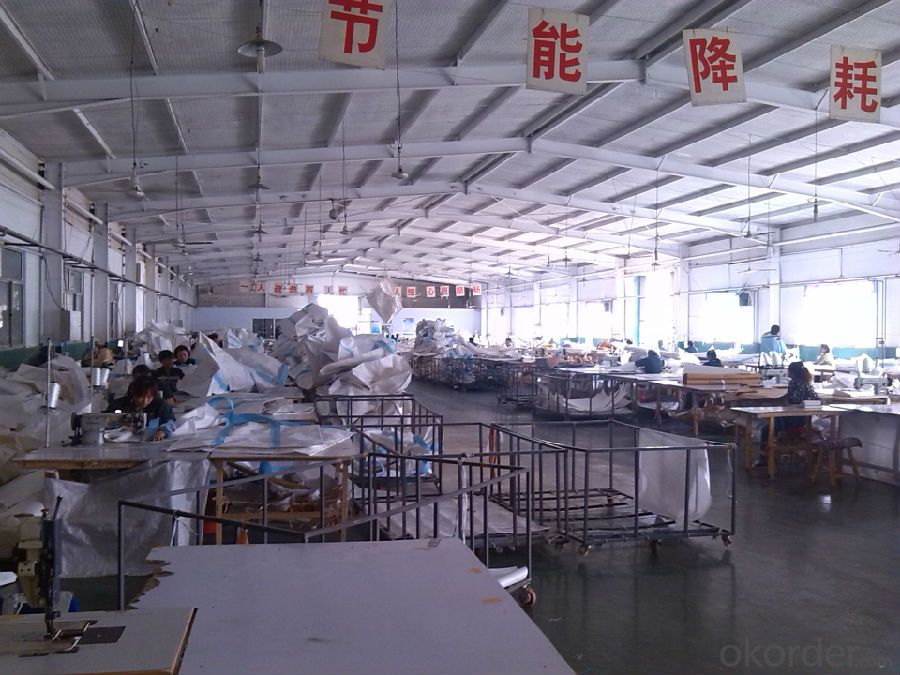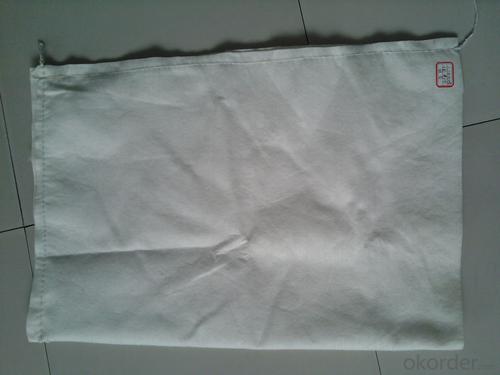Geotextile Fabric Geo Bag for Marine Embankment and River Bank Paver Patio
- Loading Port:
- Qingdao
- Payment Terms:
- TT OR LC
- Min Order Qty:
- 30000 pc
- Supply Capability:
- 500000 pc/month
OKorder Service Pledge
OKorder Financial Service
You Might Also Like
Description Of Geo Bag for Marine Embankment and River Bank
Geotextile bags and geotubes are extension products of non woven geotextile, nomally made of high-performance PP or PET non woven geotextile.used for the protection of hydraulic structures and riverbanks from severe erosion and scouring.
Main Features of Geo Bag for Marine Embankment and River Bank
Good filtrations as the pore size are small but the permeability is high.
Protects the terrestrial habitat.
Good abrasive resistance.
Fabric stability is more than in woven fabric
Higher thickness which ensures good puncture resistance
Easily available
Implemented easily
Easy to transport when empty
Available in various sizes to fit specific applications.
Specifications of Geo Bag for Marine Embankment and River Bank
1. equipment introduced from Italy.
2. Polypropylene (PP) , Polyester (PET) material
Staple fiber ( Short fiber) needle punched
3. weight: 100g/m² to 1200g/m²
4. Customized color and size
Project Model | 100 | 150 | 200 | 250 | 300 | 350 | 400 | 450 | 500 | 600 | 800 | Remarks | |||||||
Weight difference on unit area ,% | -8 | -8 | -8 | -8 | -7 | -7 | -7 | -7 | -6 | -6 | -6 | ||||||||
Thickness,mm >= | 0.9 | 1.3 | 1.7 | 2.1 | 2.4 | 3.5 | 4.2 | 5.3 | 7.6 | 10.0 | 14.2 | ||||||||
Width deviation,% | -0.5 | ||||||||||||||||||
Breaking strength,KN/m >= | 2.5 | 4.5 | 6.5 | 8.0 | 9.5 | 11.0 | 12.5 | 14.0 | 16.0 | 19.0 | 25.0 | Longitudinal Transverse | |||||||
Elongation at break,% | 25~100 | ||||||||||||||||||
CBR-test,KN >= | 0.3 | 0.6 | 0.9 | 1.2 | 1.5 | 1.8 | 2.1 | 2.4 | 2.7 | 3.2 | 4.0 | ||||||||
Equivalent opening size (EOS) O90,mm | 0.07~0.2 | ||||||||||||||||||
Coefficient of vertical permeability. cm/s | K×(10-1~10-3) | ||||||||||||||||||
Tearing strength,KN >= | 0.08 | 0.12 | 0.16 | 0.20 | 0.24 | 0.28 | 0.33 | 0.38 | 0.42 | 0.46 | 0.60 | Longitudinal Transverse | |||||||
Geo Bag for Marine Embankment and River Bank Images




FAQ
1. Do you supply free samples for customers?
Yes,we will supply free samples for you.Please send your address for us.
2. How Many years experience do you have?
We have been exported to more than 20 countries in the past 15 years.
3. How long do we usually reply your request?
We always reply our customer within 24 hours.
- Q: What are the different geotextile installation techniques for landfill applications?
- There are several geotextile installation techniques commonly used for landfill applications. These include the direct placement method, the trench method, the soil cover method, and the liner method. The direct placement method involves placing the geotextile directly on the subgrade or waste material, while the trench method involves placing the geotextile in a trench and then covering it with soil. The soil cover method involves placing the geotextile on top of the waste material and then covering it with a layer of soil. The liner method involves placing the geotextile on top of a geomembrane liner to provide additional protection and support. Each method has its own advantages and considerations depending on the specific requirements of the landfill site.
- Q: Geotextile lap joint with special equipment? How is the price
- Geotextile stitching is a professional equipment, professional equipment name for the portable sewing machine, the price is cheaper, generally ranging from 100-300 yuan. Look like this:
- Q: Can geotextiles be used in geosynthetic clay liners?
- Yes, geotextiles can be used in geosynthetic clay liners. Geotextiles are often used as a separation layer between the clay liner and the adjacent soil or as a protective barrier to prevent punctures or damage to the clay liner.
- Q: How do geotextiles improve the performance of geocomposites?
- Geotextiles improve the performance of geocomposites by enhancing their strength, durability, and filtration capabilities. They act as a reinforcement layer, distributing the load and preventing the geocomposite from shifting or deforming under stress. Additionally, geotextiles provide filtration, allowing water to flow through while retaining soil particles, which helps in preventing clogging and maintaining the long-term performance of the geocomposite.
- Q: Geotextile manufacturers are what industry
- Petrochemical! Raw materials are all extracted from the oil out of the glial particles!
- Q: Are geotextiles commonly used in agriculture?
- Yes, geotextiles are commonly used in agriculture. They are used for various purposes such as erosion control, soil stabilization, weed suppression, and moisture retention. Geotextiles help improve crop yield, reduce water usage, and prevent soil erosion, making them an essential component in modern agricultural practices.
- Q: The secondary lining of the tunnel to install the vertical ring to the blind tube hang the geotextile waterproof board generally used for how long
- See the progress of the project
- Q: What are the applications of geotextiles?
- Geotextiles have a wide range of applications in civil engineering and environmental projects. They are commonly used in road construction, where they provide stability, erosion control, and reinforcement. Geotextiles are also utilized in landfills to separate and protect soil layers, preventing contamination. Additionally, they are employed in coastal engineering to mitigate erosion and stabilize shorelines. Geotextiles are also used in drainage systems, agriculture, and landscaping to control erosion, filter water, and promote vegetation growth.
- Q: Can geotextiles be used in geosynthetic clay liner caps?
- Yes, geotextiles can be used in geosynthetic clay liner caps. Geotextiles are often used as a protective layer over geosynthetic clay liners to prevent soil intrusion, enhance filtration, and provide additional stability to the liner system.
Send your message to us
Geotextile Fabric Geo Bag for Marine Embankment and River Bank Paver Patio
- Loading Port:
- Qingdao
- Payment Terms:
- TT OR LC
- Min Order Qty:
- 30000 pc
- Supply Capability:
- 500000 pc/month
OKorder Service Pledge
OKorder Financial Service
Similar products
Hot products
Hot Searches
Related keywords


































